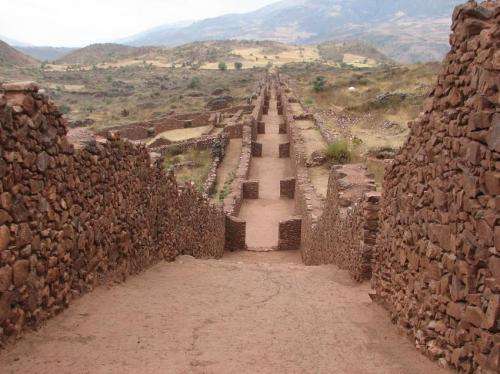June 18, 2014 report
DNA study on mummies suggests climate instability drove ancient Peruvians to migrate

(Phys.org) —An international team of researchers has concluded that migrations by pre-Columbian Andean societies were due to climatic changes, rather than growth in the Wari empire, as was previously suggested. In their paper published in Proceedings of the National Academy of Sciences, the team describes how they conducted mitochondrial DNA analysis on mummies from the period combined with a Bayesian modeling approach to trace the migration activities of the people that lived in Peru between 840 BC and 1450 AD.
To gain a clearer understanding of early Nasca, Wari and Tiwanaku peoples living in various parts of what is now Peru, the researchers collected DNA samples from 207 mummies found in both coastal and mountainous parts of the region. Mitochondrial analysis and Bayesian modeling indicated that people that had been living near the coast began migrating to the mountains sometime around 640 BC. They also found evidence of a reverse migration as people from the mountains migrated towards the coast around 1200 AD.
The researchers compared the DNA evidence with prior research on climatic conditions during the same period. They found that around roughly 640 BC, climate variability due to el Nino or el Nina would have made growing crops in coastal valleys challenging. Also, they found that the highlands areas experienced a long term drought that began around 1200 AD, which would have driven people back down to the coasts. Both climate events coincide with the DNA evidence.
Prior to this research, the general consensus among historians has been that the migrations that occurred in the area at the time were most likely due to the expansion and eventual collapse of the Wari empire. Now it appears that it was instead driven by climactic change, forcing people to move to where conditions were favorable for growing their food. The researchers note that the change would likely have had to have been significant as the people in the ancient societies demonstrated anticipatory agricultural adaptations that allowed them to cope with both floods and drought. The team notes that migrating back and forth between the coast and the highlands also appears to have caused homogenization of the peoples from the two areas.
More information: Climate change underlies global demographic, genetic, and cultural transitions in pre-Columbian southern Peru, Lars Fehren-Schmitz, PNAS, doi: 10.1073/pnas.1403466111
Abstract
Several archaeological studies in the Central Andes have pointed at the temporal coincidence of climatic fluctuations (both long- and short-term) and episodes of cultural transition and changes of socioeconomic structures throughout the pre-Columbian period. Although most scholars explain the connection between environmental and cultural changes by the impact of climatic alterations on the capacities of the ecosystems inhabited by pre-Columbian cultures, direct evidence for assumed demographic consequences is missing so far. In this study, we address directly the impact of climatic changes on the spatial population dynamics of the Central Andes. We use a large dataset of pre-Columbian mitochondrial DNA sequences from the northern Rio Grande de Nasca drainage (RGND) in southern Peru, dating from ∼840 BC to 1450 AD. Alternative demographic scenarios are tested using Bayesian serial coalescent simulations in an approximate Bayesian computational framework. Our results indicate migrations from the lower coastal valleys of southern Peru into the Andean highlands coincident with increasing climate variability at the end of the Nasca culture at ∼640 AD. We also find support for a back-migration from the highlands to the coast coincident with droughts in the southeastern Andean highlands and improvement of climatic conditions on the coast after the decline of the Wari and Tiwanaku empires (∼1200 AD), leading to a genetic homogenization in the RGND and probably southern Peru as a whole.
Journal information: Proceedings of the National Academy of Sciences
© 2014 Phys.org



















